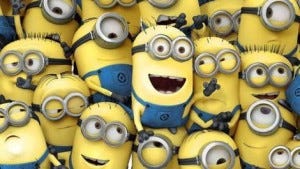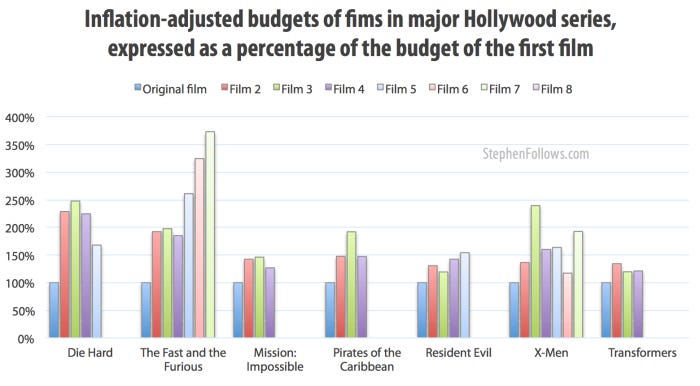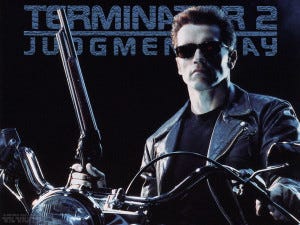Hollywood sequels by the numbers

Last week's article on how original Hollywood movies are had such a great response that I've rushed out a sequel featuring many of the same characters. Not only that, but I've twigged that I can split the follow-up into two parts to maximise my audience. (I may have been studying Hollywood for too long...) This week I am looking at Hollywood sequels and next week I will be addressing remakes and reboots. I looked at the 100 highest US grossing films of each of the past 10 years, focusing on Hollywood sequels and prequels. In summary...
In the past 10 years, the number of top grossing films which were sequels has more than doubled
In both 2013 and 2014, seven of the top 10 grossing films were either sequels or prequels.
Almost half of all the money spent on Adventure and Action films in the past decade has gone to sequels or prequels.
Only one romantic comedy sequel has appeared in the top grossing films 2005-14 (Think Like a Man Too)
Of the top 50 highest grossing films of all time, 33 films reference events which took place in another film on the same list
The Paranormal Activity series has an unofficial sequel called Paranormal Activity 2: Tokyo Night, which was made by a Japanese distributor
Terminator 2 was budgeted at 1,207% of the original Terminator film.
Are there an increasing number of Hollywood sequels?
Yes. In the past 10 years, the number of films in the top 100 grossing films (US B.O.) which were sequels has more than doubled, from 9% in 2005 to 22% in 2014. In both 2013 and 2014, seven of the top 10 grossing films were either Hollywood sequels or prequels.
Which genres are most sequel-friendly?
Almost half of all the money spent on Adventure and action films in the past decade has gone to sequels or prequels. By contrast, only one romantic comedy sequel has appeared in the top 100 grossing films of each year 2005-14 - Think Like a Man Too.

Has Hollywood always been hot for sequels?
My research looked at the past 10 years and, as we've seen, shows a big increase in Hollywood sequels. To put this trend in a wider context I looked at some extensive research carried out by Stuart Henderson, author of The Hollywood Sequel: History & Form. He was kind enough to share with me his dataset of film sequels, prequels and series released in North America between 1910 and 2010.

Measuring the film series

In the early days of film, Hollywood loved producing films within a series but which were not direct sequels. There were at least 19 film series each with over 10 films, and the biggest was The Durango Kid which included 64 films between 1945 and 1952 (yes, that's more than nine a year on average). Whether a film is a sequel or just part of the overall series is a fine line. Stuart Henderson says "The difference between a sequel and a series film as I see it is that the latter films, although they feature recurring characters, almost never acknowledge the events of previous films in the series". Using Stuart's definition, we can see that Hollywood used to be very keen on non-sequel series films but that this has given way to more direct sequels and prequels.

So is the idea of a film series dead?

No, it's just changed. The standalone films within a 'film series' have largely given way to an abundance of Hollywood sequels, prequels and spinoffs under the banner of 'franchises'. Of the top 50 highest grossing films of all time, 33 films reference events which took place in another film on the same list. They are Harry Potter (8 films), Tolkien (6 films), Transformers (3 films), Pirates of the Caribbean (3 films), Marvel universe (3 films), Fast & Furious (2 films), Nolan's Batman (2 films), Shrek (2 films), Ice Age (2 films) and Star Wars (2 films).
Researching current movies series / franchises
Researching film series bring up a number of questions, the answers to which are highly subjective. These include...

What is a series? Do the recent spate of films from Marvel constitute one series or a collection of smaller series? Wikipedia lists it as one, called the Marvel Cinematic Universe, but it could also be true to say that Marvel has made six interrelated film series: that of Iron Man (3 films), The Hulk (1 or 2 films, depending on whether you regard the Ang Lee film as part of this series), Thor (2 films), Captain America (2 films), The Avengers (2 films) and Guardians of the Galaxy (1 film).
How do we treat film series which have changed significantly over time? The Pink Panther film series started in 1963 with the Peter Sellers classic 'The Pink Panther' and its eleventh film was released in 2009, confusingly called 'The Pink Panther 2'. One could regard this as a single continuing series, as two series (1963-1993 and 2006-2009) or even as three if you regard the 1993 film Son of Pink Panther as not truly connected with the previous eight films.
How do we cope with illegal or non-canonical films? In 1967, a film spoof of the spy genre was released, based on Ian Fleming's first James Bond novel Casino Royale. It features David Niven as "James Bond" and six other actors play characters called "James Bond 007", including Peter Sellers and Ursula Andress. Few Bond buffs regard this film as being part of the official Bond series but this is a subjective opinion. Likewise, the Paranormal Activity series has an unofficial sequel called Paranormal Activity 2: Tokyo Night, which was made by a Japanese distributor and the film is not normally regarded as being part of the Paranormal Activity canon. An official sequel, Paranormal Activity 2, was released by Paramount in the same year as the unofficial film.
Because of points like these, I've not been able to take my usual method (i.e. using an objective set of specific criteria to create a robust, complete dataset to measure and spot trends). However, I can take individual film series and look at them as anecdotal case studies. Examples of when the second film costs considerably more than the original (all budgets have been adjusted for inflation)...
Terminator 2 was budgeted at 1,207% of the original Terminator film.
Rocky 2's budget was 534% that of Rocky
Saw 2 was 404% more expensive than Saw.
The vast majority of Hollywood sequels cost more than their originals. I could only find a few exceptions to this...
Harry Potter and the Chamber of Secrets (2002) cost 79% of the budget of Harry Potter and the Sorcerer's Stone (2001)
Kick-Ass 2 was budgeted at 88% of Kick-Ass
The Amazing Spider-Man 2's budget was 85% of the original (by 'original' I mean the first of the reboot of the film series adapted from the comic books)

Data sources
I gathered my Data from IMDb, The Numbers / Opus, Box Office Mojo and Wikipedia. Stuart Henderson lists his data sources as...
Internet Movie Database (www.imdb.com), the American Film Institute Catalogue and a selection of published, encyclopaedic reference guides to cinematic seriality: Bernard Drew, Motion Picture Series & Sequels: A Reference Guide (New York: Garland, 1990); Robert A. Nowlan & Gwendolyn Wright Nolan, Cinema Sequels & Remakes, 1903-87 (North Carolina: McFarland, 1989); and James L. Limbacher, Haven’t I Seen You Somewhere Before? Remakes, Sequels, and Series in Motion Pictures, Video and Television, 1896-1990 (New York: Pierian, 1992).
Of his dataset, Stuart says...
Inevitably, the information included here is not exhaustive. There are no doubt certain films which have not been captured by my research, particularly in the period between 1911 and 1929, where the available records are unlikely to be complete. Nonetheless, I believe this represents a relatively comprehensive and representative set of data, which gives a reasonably accurate impression of the levels of sequel and series production over the past century, and the broad range of films which might be bracketed under those terms.
You can buy Stuart's book The Hollywood Sequels: History & Form, 1911-2010 on Amazon by following this link.
Epilogue
Next week I will be presenting the third article in this apparent trilogy, on the subject of remakes and reboots. Let's hope that I'm not replaced by Andrew Garfield in an attempt to reboot the blog or the current generation.



